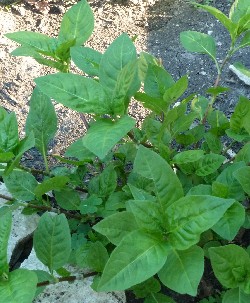Adventures
with Lichen Dyes
By
Glenna Dean, Donna Brown, Diane DeSouza and Deb McClintock
The
Fall, 2009 issue of the Turkey Red Journal
contains an article by Glenna Dean on lichen dyes
(“Introduction to Common New Mexico Dye Lichens”). During
the Taos Wool Festival on October 7, 2011, we explored
additional lichen dye extraction methods and are
presenting here some of our findings from that workshop.
For the
2011 workshop, Glenna prepared multiple extractions of
eight lichens, many collected over 20 years ago. Due to
time constraints, we used only four of those eight
lichens. All were collected sustainably: some were on the
ground having fallen from trees (Teloschistes sp.,
Pseudevernia sp.), some were on the ground in
advance of coal-mine development (Xanthoparmelia
chlorochroa), and others were piñon-pine
firewood (Usnea sp.).
| LICHENS USED FOR OCTOBER 7, 2011 WORKSHOP | |||
| Latin Name | Common Name | Collected From | Year Collected |
| Usnea(?) cavernosa | Old Man’s Beard | Northern NM | 1998 |
| Xanthoparmelia chlorochroa | Tumbleweed Shield Lichen | Northeastern NM | 1996 |
| Teloschistes exilis | Slender Orange Bush Lichen | Central Texas | 2011 |
| Pseudevernia intensa | Western Antler Lichen | Northern NM | Late 1980s |
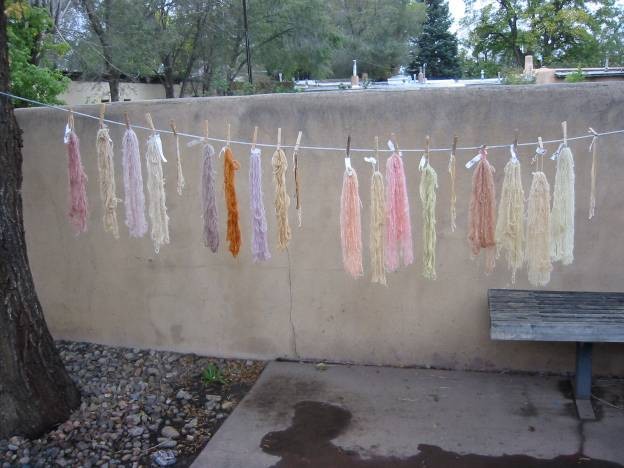
Xanthoparmelia chlorochroa, A, B, C, D, silk;
Teloschistes exilis, A, B, C, D, silk;
Pseudevernia intensa, A, B, C, D, silk.
Extracting the Dyes
Dyes from a total of 10g of each lichen were extracted using four different methods (Methods 1-3 are also described in Glenna’s 2009 article).
| Method 1 | (dye extraction in simmering water): 10g of lichen simmered for several hours in ½ gallon of rainwater, acidified to pH 6 with household vinegar. Glenna froze the strained solutions in gallon plastic containers to prevent the dyes from molding before the workshop. The strained-out lichens were rinsed and added to ammonia solutions (Method 3). |
| Method 2 | (dye extraction in 1:2 ammonia : rainwater): 10g of lichen steeped at least 3 weeks in a half-full one-gallon jar of household-ammonia solution, shaken vigorously several times daily to mix in oxygen. If available, non-sudsy ammonia is preferable, but sudsy ammonia will work. Solutions made with sudsy ammonia will foam profusely when vigorously shaken, but this will decrease as the dye extraction matures. Glenna has found the extractions to be mature when the foam breaks down within five minutes, even with sudsy ammonia. |
| Method 3 | (lichen previously simmered in water, then placed in 1:2 ammonia:rainwater): 10g of lichen previously simmered in water steeped at least 3 weeks in a half-full one-gallon jar of household-ammonia solution, shaken vigorously several times daily to mix in oxygen. |
| Method 4 | (dye extraction in 1:2 rubbing alcohol:rainwater): 10g of lichen steeped at least 3 weeks in a half-full one-gallon jar of alcohol solution, shaken vigorously several times daily to mix in oxygen. The solution was pH 6. |
Dyeing the Yarns
| Method 1 | Entire ½ gallon extracted solution for dye bath at pH 6. |
| Method 2: | 2 cups of solution neutralized with 2 cups of vinegar to pH 6 in dye pot, rainwater added as needed to float the yarn. |
| Method 3: | 2 cups of solution neutralized with 2 cups of vinegar to pH 6 in dye pot, rainwater added as needed to float the yarn. |
| Method 4: | 1 quart (half) of solution mixed with enough rainwater to float the yarn in dye bath, pH 6 |
Eight dye pots (four extracts each of two lichens) were heated in the morning session of the workshop, the other eight in the afternoon. We had planned to simmer the yarns for at least an hour, but the October day was very cold and rainy, the dye pots were outside on the porch in the wind, and the hot plates kept blowing the facility fuses. Heating yarns with the dyes probably averaged 30 minutes, well short of the several-hours-over-several-days dyeing Glenna wrote about in the 2009 article. Obviously, the resulting colors are a mere shadow of any lichen’s potential. We are focused here on the fact that different colors were achieved and, more importantly, on the calculations of how much yarn each lichen solution can dye.
Seven 5g skeins of handspun 2-ply wool yarn were heated in each dye bath (total of 35g of wool in each dye bath). The yarns were scoured but not mordanted. Most of the skeins were of New Mexico Lincoln wool, but as the New Mexico Lincoln ran out, some skeins were spun of British Lincoln roving from Louet. Small skeins of scoured, unmordanted 20/2 silk yarn were also dyed in each bath, but their total weights were not tallied. NOTE: We used hot plates; there is a danger of the alcohol dye bath catching fire if heated over open flame!
Results
of the Dyeing
According to traditional lichen-dye lore,
only two of the lichens discussed here, Teloschistes and
Pseudevernia, are considered suitable for ammonia
(“orchil-producing lichens”) as both yield reds by this
method. Conversely, by the same yardstick the other two
lichens, Usnea and Xanthoparmelia, are
considered suitable only for simmering water extraction,
by which they yield tans and lightfast browns. As noted in
Glenna’s 2009 article, all lichens she has tested so far
yield color in both ammonia and extended simmering-water
extractions. Her experiments have focused on how many
colors any lichen can yield by all of these methods, now
adding steeping in alcohol. Although it is possible that
these additional colors might not be fast (this deserves
testing), extracting all possible colors from a single
lichen makes sense ecologically, as well as artistically
for fibers not exposed to sunlight. Other than the
centuries-old use of simmering water to extract durable
shades of brown for Harris Tweed in Scotland, we do not
see (nor do we advocate) a commercial potential for lichen
dyes.
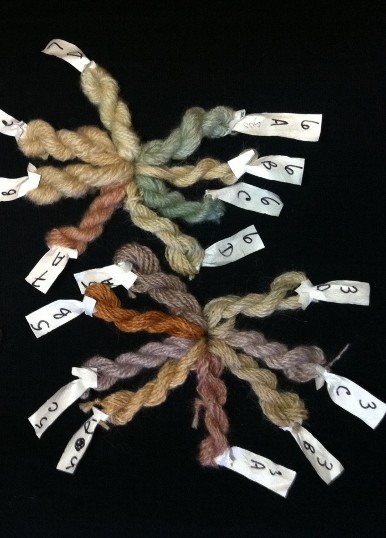
Lower Left: Xanthoparmelia chlorochroa;
Lower Right: Usnea(?) cavernosa;
Upper Right: Teloschistes exilis.
A: ammonia solution. B: simmering water.
C: lichen B re-extracted in ammonia. D: alcohol.
A large range of colors was obtained from the dye baths. Some colors were much lighter than they would have been with longer simmering or steeping; this is certainly true for Pseudevernia, which yields dark plums. While the entire simmering-water extraction from each lichen was used in this workshop, additional dye baths can still be made from the remaining ammonia and alcohol extractions to better assess the color potential of each lichen.
| LICHENS USED FOR OCTOBER 7, 2011 WORKSHOP | ||||
| Latin Name | Method 1 | Method 2 | Method 3 | Method 4 |
| Usnea(?) cavernosa | Tan | Rose-brown | Pale lavender | Ecru |
| Xanthoparmelia chlorochroa | Pumpkin | Brown-lavender | Ashes of lavender | Light chestnut |
| Teloschistes exilis | Yellow tan | Peach | Pink (turns blue when dried in direct sunlight) | Celery |
| Pseudevernia intensa | Light yellow tan | Light cutch | Tea | Antique White |
Yarn samples
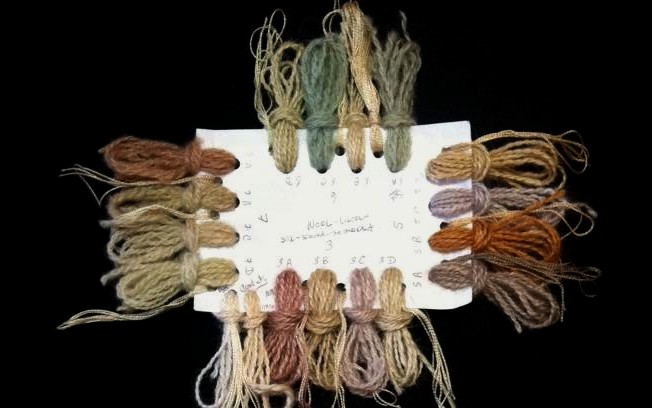
Left: Pseudevernia intensa;
Bottom: Usnea(?) cavernosa;
Right: Xanthoparmelia chlorochroa.
A: ammonia solution. B: simmering water.
C: lichen B re-extracted in ammonia. D: alcohol.
So How Much Yarn Can Lichen Dyes Dye?
| Method 1 | 10g of lichen yielded ½ gallon of solution, which dyed 35g of wool yarn and an unknown weight of 20/2 silk yarn. A full-strength long-simmered dye bath would dye more yarn in increasingly lighter colors; lichens that specifically yield brown dyes (Xanthoparmelia) would dye more yarn as well. |
| Method 2: | 10g of lichen yielded ½ gallon of solution, 2 cups of which (25%) dyed 35g of wool yarn and an unknown weight of 20/2 silk yarn. By extrapolation, an ammonia solution from 10g of lichen could dye as much as 140g of wool yarn (enough for a pair of socks), even more in increasingly lighter colors. |
| Method 3: | Reuses the same 10g of lichen from Method 1. The second extraction yielded ½ gallon of solution, 2 cups of which (25%) dyed 35g of wool yarn and an unknown weight of 20/2 silk yarn. By extrapolation, an ammonia solution from 10g of reused lichen could dye as much as 140g of wool yarn (enough for a scarf), even more in increasingly lighter colors. |
| Method 4: | 10g of lichen yielded ½ gallon of solution, 1 quart of which (50%) dyed 35g of wool yarn and an unknown weight of 20/2 silk yarn. By extrapolation, an alcohol solution from 10g of lichen could dye as much as 70g of wool yarn, even more in increasingly lighter colors. |
Discussion
The
photos show the minimum amount of color that can be
expected from lichens extracted as discussed here. There
simply wasn’t enough time during the workshop to heat,
cool, and reheat the yarn in the dye baths, as Glenna has
done in the past. In some cases the dye baths never
achieved even a simmer. Additionally, the ammonia (and
probably the alcohol) extractions would have benefited
from a longer period of steeping and vigorous shaking, as
the dyes develop slowly over time in contact with oxygen.
There appears to be no substitute for long extraction and
repeated simmering of all the lichen dyes, whether with
water, ammonia, or alcohol.
That said, the lichens produced some surprises during the workshop.
- The ammonia extraction of Usnea (?) cavernosa produced a red-tending rose while the ammonia re-extraction of the same water-simmered lichen produced a blue-tending light lavender.
- Brown-dyeing Xanthoparmelia chlorochroa produced a lovely lavender in the ammonia re-extraction of the water-simmered lichen.
- The ammonia extraction of Teloschistes exilis (and the ammonia re-extraction of the water-simmered lichen) are known to dye wool pink (as seen in the drying-line photo), but the color changes to a slate blue while the damp yarn evaporates the dye bath in direct sunlight (this color change is permanent). Just how crucial the intensity of sunlight is to changing the color was documented by Deb who kept her samples damp with ice cubes on the dashboard as she drove back home; none achieved the depth of hue of the samples Diane sun-dried in New Mexico’s thin air at about 7,000 feet. The alcohol extract of this lichen dyed a definite green as seen on the drying-line, but the color shifted to a neutral over a few weeks.
- All of the pale colors from normally vivid Pseudevernia intensa were a disappointment – very likely due to under-development of the dyes. Glenna has not noticed that properly stored lichens lose dyeing strength over time.
- On the drying-line, one of the lichens produced a lovely fragrance that vanished after a few weeks.
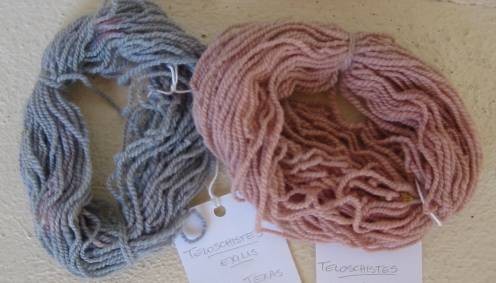
Right: Ammonia-extracted pink dye.
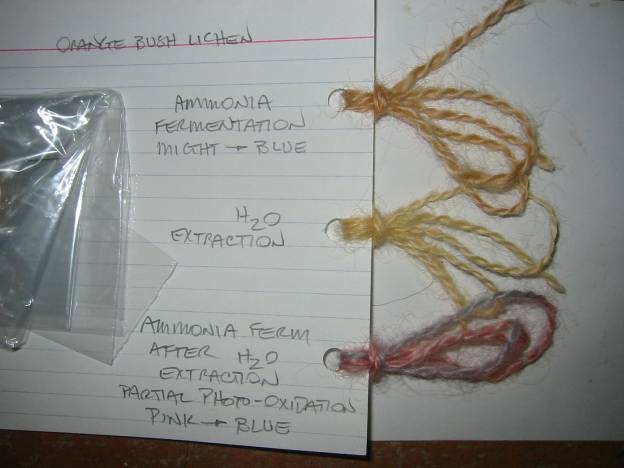
On the point of how much color a given amount of lichen can yield, Deb has found that a lichen can be re-extracted several times in ammonia to yield additional color, which will obviously increase the potential amount of yarn dyed (for example, brown or rose from first steeping, deep roses from a second steeping, and pinks from a third steeping). When it comes to lichen dyeing, it seems that patience – and recycling – are the keys to achieving limitless colors.
Additional
Reading
Brodo,
Irwin M., Sylvia Duran Sharnoff and Stephen Sharnoff
(2001) Lichens of North America. Yale University
Press, New Haven.
Karen
Diadick Casselman (2001 Dover edition) Lichen Dyes: The
new source book. Dover Books, New York.
Dominique
Cardon (2007) Natural Dyes: Sources, tradition,
technology and science. Archetype Publications,
London.
 Turkey Red Journal
Turkey Red Journal
